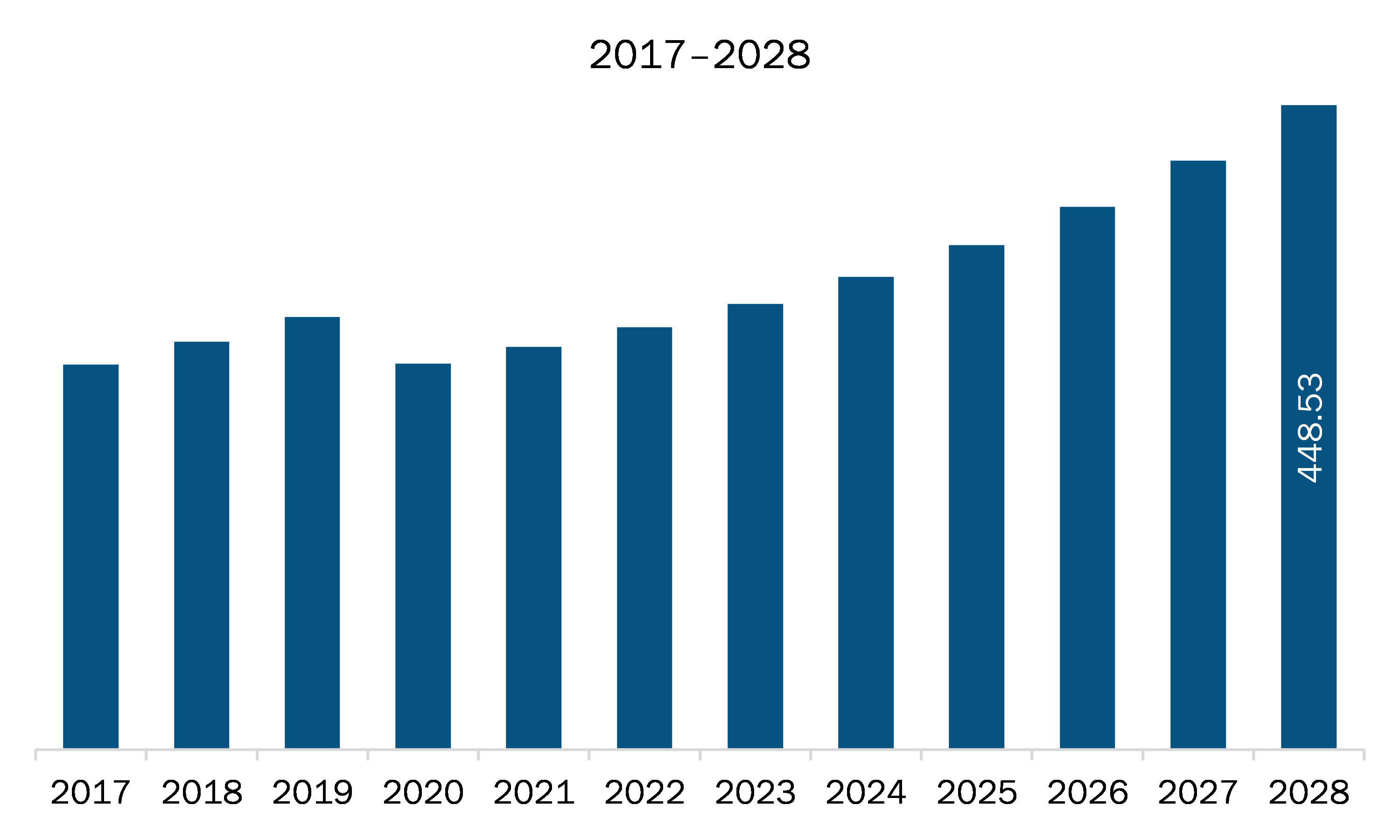The machine vision lighting market in North America is expected to grow from US$ 280.29 million in 2021 to US$ 448.53 million by 2028; it is estimated to grow at a CAGR of 6.9% from 2021 to 2028.
The US, Canada, and Mexico are major economies in North America. Huge demand for high production output is the major factor driving the growth of the North America machine vision lighting market. Lighting is a significant factor of any application of machine vision. Appropriate lighting guarantees a reliable environment for machine vision systems to detect or scrutinize objects, resulting in enhanced accuracy, repeatability as well as quality in production.
The increasing market competition has its impetus on North America manufacturers to decrease production errors and operating expenditure. Therefore, North America manufacturers are increasingly embedding advanced solutions to their production line to manufacture quality products along with minimized production errors. The manufacturing industries these days are more focused on cost-effective manufacturing and packaging technologies, which can protect the brand and quality of the products. Irrespective of some sectors, the manufacturing industries demand for a specialized knowledge for control and automation of processes.
Due to the massive sale of products, error prevention and automation has risen dramatically in recent years. All the specifications of the production are expected to be handled with perfection, ensuring the maximization of the uptime, thus, through the specifications, the low-quality products are rejected, and operating costs are reduced. Additionally, all regulatory expectations are either met or exceeded. Proper lighting in machine vision thus, plays an important role in maintaining the quality of products. Since machine vision systems examine the image of the object, hence it is vital to get the precise lighting arrangement for the application. This enables the camera to capture all image details essential to make exact measurements. Higher levels of integration help in increasing product quality as well as production efficiency, thus, reducing production cost.
North America has the highest adoption and growth rate of new technologies owing to favorable government policies to boost innovation and strengthen the infrastructure capabilities. Hence, any impact on industries is expected to affect the economic growth of the region in a negative manner. Presently, the US is the world’s worst affected country due to the COVID-19 outbreak, thereby influencing the sudden stands still across all industries such as manufacturing and automotive.It is becoming apparent with the COVID-19 pandemic spreading across the US that a few can escape its scope, presenting significant challenges to all industries. However, the manufacturing sector is adopting technologies to convert traditional manufacturing processes into smart ones. Thus, the closure of all manufacturing units across countries such as the US, Canada, and Mexico is expected to negatively impact the growth of the machine vision lighting market. However, the outbreak of the virus has influenced the adoption of the technology across the healthcare sector to detect COVID-19 among patients. Thus, rising investment by the healthcare sector in technologies in the present situation is expected to impact the market positively. As a result, the sector was able to cope with the pandemic's predicament in a relatively short time. This industry is currently operating at the same rate as it did prior to the outbreak. Thus, North America is expected to witness an overall moderate impact on the machine vision lighting market owing to the pandemic in the coming years.
With the new features and technologies, vendors can attract new customers and expand their footprints in emerging markets. This factor is likely to drive the North America machine vision lighting market. The North America machine vision lighting market is expected to grow at a good CAGR during the forecast period.

- This FREE sample will include data analysis, ranging from market trends to estimates and forecasts.
North America Machine Vision Lighting Market Segmentation
North America Machine Vision Lighting Market – By Lighting Type
- LEDs
- Fiber Optic Lights (Halogen)
- Florescent Lighting
- Xenon
- Others
North America Machine Vision Lighting Market – By Spectrum of Light
- Visible spectrum
- UV Spectrum
- IR spectrum
North America Machine Vision Lighting Market – By Application
- Automotive
- Consumer Electronics
- Food & Beverage
- Pharmaceuticals
- Logistics
- Others
North America Machine Vision Lighting Market, by Country
- US
- Canada
- Mexico
North America Machine Vision Lighting Market - Companies Mentioned
- Advanced Illumination Inc
- Cognex Corporation
- EFFILUX
- Moritex Corporation
- National Instruments Corporation
- Omron Microscan System, Inc.
- ProPhotonix Limited
- Smart Vision Lights
- Spectrum Illumination
- TPL Vision
North America Machine Vision Lighting Report Scope
| Report Attribute | Details |
|---|---|
| Market size in 2021 | US$ 280.29 Million |
| Market Size by 2028 | US$ 448.53 Million |
| CAGR (2021 - 2028) | 6.9% |
| Historical Data | 2019-2020 |
| Forecast period | 2022-2028 |
| Segments Covered |
By Lighting Type
|
| Regions and Countries Covered |
North America
|
| Market leaders and key company profiles |
|
- Historical Analysis (2 Years), Base Year, Forecast (7 Years) with CAGR
- PEST and SWOT Analysis
- Market Size Value / Volume - Regional, Country
- Industry and Competitive Landscape
- Excel Dataset
Recent Reports
Testimonials
Reason to Buy
- Informed Decision-Making
- Understanding Market Dynamics
- Competitive Analysis
- Identifying Emerging Markets
- Customer Insights
- Market Forecasts
- Risk Mitigation
- Boosting Operational Efficiency
- Strategic Planning
- Investment Justification
- Tracking Industry Innovations
- Aligning with Regulatory Trends






















 Get Free Sample For
Get Free Sample For